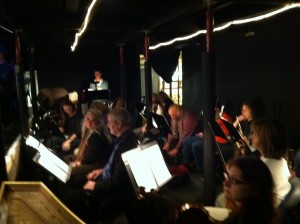January 19, 2012
For the chamber musician (and the orchestra of Opera Lafayette consists of chamber musicians), the pit is a torturous music chamber, an uncomfortable dream come true. After two days of preparing the score of Monsigny’s Le Roi et le fermier with instruments and singers in a large rehearsal room at the Atlas Performing Arts Center, we are ready to put the singers on stage and work the magic of theater. For the instrumentalists, this means becoming invisible. It is part of the magic.

We have examined and rehearsed each aria and recitative, becoming familiar with the words of Sedaine and the music of Monsigny. Our singers have brought character and passion to the roles and though none of the musicians would say that this is music of great genius, we respond to its charm, easy flowing melodies, historical interest, and particularly to Ryan Brown’s “right on” concept of the work.
Today, moving closer to opening night, we descend into the pit for the first time. Getting there involves walking down a few flights of steps. We notice cracked concrete walls, yellow brown water stains on the floor and walls, and from time to time a black plastic rat poison motel placed in the corners of the stairwell. We all proceed holding our instruments and we edit what we see. No need to consider the implications of the Decon traps!
The pit is painted and draped black. Iron posts that support the stage above our heads, JUST above our heads are encased in soft black plastic tubing to protect us from banging our heads, hands, or instruments. The space is very tight and for the first 15 minutes we are adjusting chairs and stands to grab just enough room for our bows, our instruments and to try and avoid scuffles with our neighbors who also need more room.
Do you remember those Bible or ancient Rome epics produced in Hollywood in the 1950s? Many of the films had episodes in which we saw galley slaves seated on benches in the bottom of the boat. There was a drummer—boom, boom, boom, who set the pace of the rowing and with each drumbeat, all the slaves pull, then push, then pull then push. Well, we wait for Ryan to come and beat that drum!

Performing with singers in a concert setting allows for contact between vocalist and accompanists. Loretta O’Sullivan and I are able to look at the lips of the singer to match his or her T or B or d or AHHHHH, with chords that need to support and harmonize the text and melody. The singer’s breath patterns, all somewhat unique, are clear for us and we can accommodate those needs. A good continuo group is flexible and can serve each singer’s talents and requirements. There is great satisfaction in performing vocal music because of this relationship. But in the pit, we see and even hear almost nothing! Is there staging? We only hear the footfalls above us. Are there words? We can make out only 2 or 3.
In the pit we must rely on Ryan’s ability to delineate the beat, and to show us, with his hands, the necessary and artful flexibilities taken by each singer. It takes a fine conductor and over the last years, Ryan has become just that!




Leave a Reply